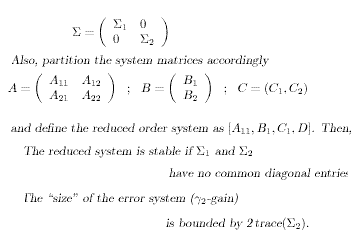|
In addition to an energy-related ranking of the states, balanced realizations have desirable numerical properties. That is, the system matrices are full and the magnitude of their entries is distributed more evenly than other canonical forms. The practical implication of this is that computations using balanced realizations are less prone to numerical problems than, say , controllable canonical forms ( this is not a precise statement ). It should also be mentioned that balanced realizations can be defined and computed for no minimal stable systems. These, however, a considerably more involved computation ( a sequence of four transformations).
In ja balanced realization, the model reduction problem is greatly simplified. In addition, the reduction error satisfies attractive system-gain bounds. The properties of this balanced truncation algorithm for model reduction are described by the following theorem.
4.6.2 Theorem: (Balanced truncation) let [A,B,C,D] be a balanced realization of a stable system. Denote the balanced Grammians by { and consider the partition

The proof is rather involved and is omitted but a few remarks on the application of the theorem are in order.
the balanced truncation is applicable to the reduction of minimal stable systems of arbitrary dimensions, number of inputs and outputs. Although the minimality assumption can be relaxed, stability cannot, to handle unstable systems, stable / anti-stable decomposition is performed first: the stable subsystem is then reduced while the anti-stable is preserved without change.
During the reduction, care should be exercised to avoid splitting equal or similar singular values. Typically, the portioning is selected at a point where the balanced Gramian singular values exhibit a �gap�.
The error bounds are fairly attractive but the reduction is not optimal in the O2-gain sense. Nevertheless, the algorithm produces reasonably good results.
With some modifications, the balanced truncation can be used to perform a (very useful) frequency-weighted reduction. In practice this algorithm is quite efficient. Unfortunately, there is no general error bounds for this approximation and the reduced order model is not guaranteed to be stable either.
Special cases of weighted reduction are the relative and multiplicative reductions. In these cases, special formulae are available and the results are similar to the un-weighted balanced truncation ( stability guarantees and error bounds). They do, however, require the system to be square (same number of inputs and outputs).
|